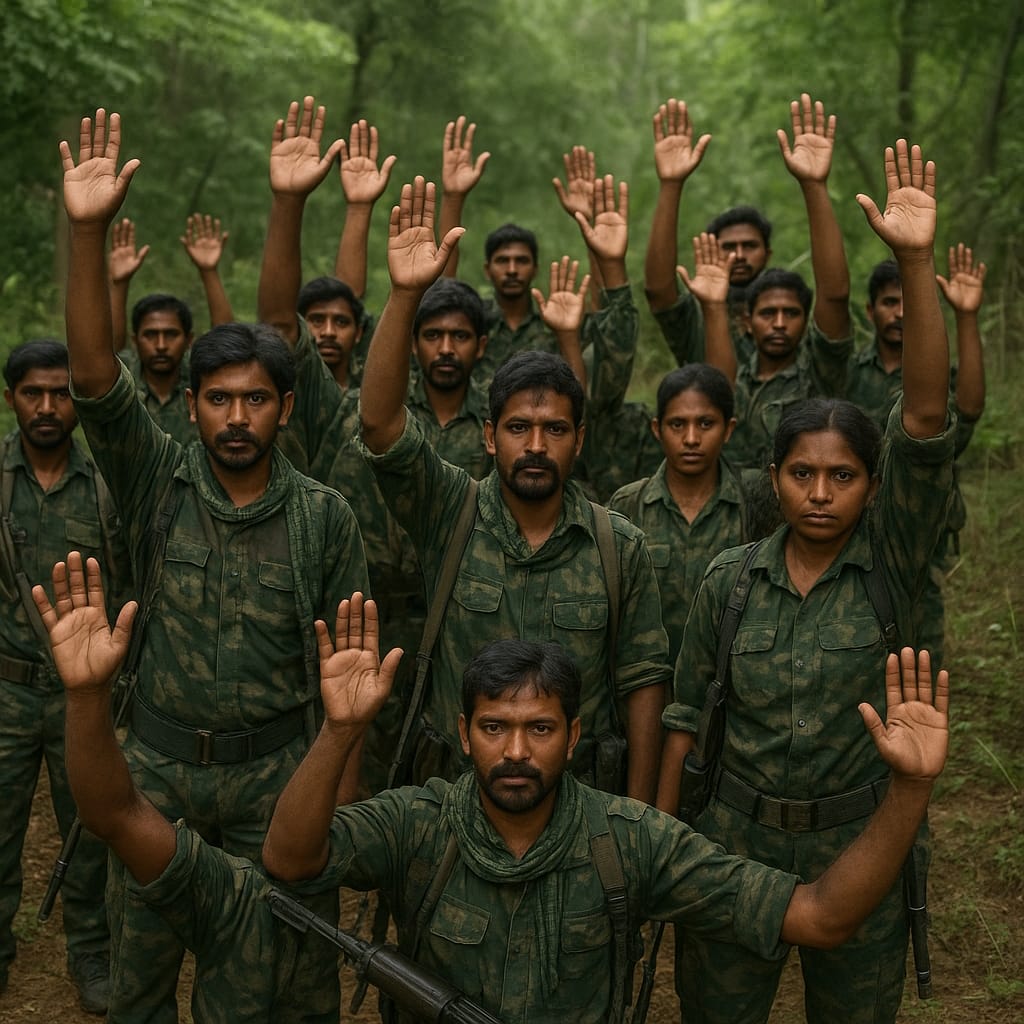16 Naxals Surrender in Chhattisgarh Narayanpur district, a clear sign that the ground is shifting. Nine of them carried rewards that add up to Rs 48 lakh, and the group included several women. It marks one of the more visible breaks from the insurgency in recent months.
Table of Contents
Police said the cadres were tired of violence and empty promises. Many spoke about exploitation, internal rifts, and how innocent tribal communities suffered. That disillusionment, paired with steady outreach, pushed them to walk away.
This surrender did not happen in a vacuum. The state has ramped up pressure while expanding rehabilitation, including an initial Rs 50,000 in assistance for each person and a path back into community life. Villagers also played a role, urging fighters to choose peace over guns.
It fits a larger trend across Bastar, slow but steady, where lower-level Maoists are rethinking the fight. New surrenders, better information from locals, and a clearer support system are changing the calculus. The goal is to curb the insurgency, and the timeline is getting tighter with a 2026 target on the table.
In this post, we will unpack why these 16 left, what they revealed about life inside the ranks, and how this affects security on the ground. We will also look at what this means for tribal communities, and whether the momentum can hold. Stay with this, the details tell a bigger story about peace taking root.
What Happened in the Surrender: Key Details from Narayanpur
16 Naxalite Surrender in Chhattisgarh : 16 members of CPI (Maoist) turned themselves in to police in Narayanpur. Most were foot soldiers or support hands, not commanders. Nine of them had rewards that added up to Rs 48 lakh. Seven were women. They said the group’s ways did not match the promises and that local tribals were paying the price. This fits the state’s push to loosen the Maoist grip in tribal belts through pressure, outreach, and steady rehabilitation.
The People Behind the Surrender
These were mostly lower-rank cadres who kept the machinery running. Many worked in Janatana Sarkar units and the cultural wing, while others served as militia and village spotters. Their work looked like errands, yet it carried risk. They ferried supplies and messages, helped with scouting, and were told to plant IEDs or watch troop movement at night.
Personal accounts shared after the surrender point to a grind with no safety net. Several said leaders treated them like expendable labor. Women faced extra control, harsher discipline, and no say in decisions. The group included seven women, a detail reported alongside the surrender update in Narayanpur, which tracks with what officials have said about the pressure on women inside the ranks. For context on the event and gender split, see this report on the Narayanpur surrender from The Tribune India: 16 Naxalites surrender in Chhattisgarh’s Narayanpur.
Many also spoke about harm to innocent tribals. They watched villagers forced to carry loads, feed squads, or face retribution. That steady harm, mixed with empty promises, pushed them to walk away.
Bounties and Rewards: What They Gained by Quitting
Nine of the sixteen had rewards on their heads, together worth Rs 48 lakh. That works out to an average of about Rs 5.3 lakh per person, though actual amounts differed by alleged role and cases. The scale of the bounty pool shows that even ground-level cadres get marked once tied to explosives, ambush support, or supply chains. The Times of India summary of the surrender provides that headline figure and context: 16 Naxals surrender in Chhattisgarh, carried Rs 48 lakh bounty.
On the other side of that risk sits a clear incentive to quit. Under Chhattisgarh’s surrender and rehabilitation policy, each person receives Rs 50,000 as immediate support, a clean start for documents, and access to longer-term assistance. Local reports have repeatedly cited the Rs 50,000 first-step aid for each surrender this year, like this coverage that tracks the state’s policy rollouts and outcomes: CG Naxal surrender: 16 Naxalites surrender.
The appeal grows when village-focused schemes are in play. Programs such as Niyad Nellanar bring roads, jobs, and basic services closer to forest hamlets. For someone weighing a return, that means a path home with support, not a dead end. Together with pressure operations, these incentives make surrender not just safer, but smarter for those stuck at the bottom of the chain.
Why These Naxals Lost Faith in Violence
Many of the 16 who surrendered in Narayanpur said the fight had stopped making sense. The slogans no longer matched what they saw in the villages. They watched fear spread faster than any message of justice. That slow break from the cause often starts with one hard moment, then another, until peace feels like the only honest choice. Reports from the surrender back this mix of disillusionment and regret, with accounts of harm to locals and rifts within the ranks. For context on the event and reasons given, see The Hindu’s coverage of the Narayanpur surrender: Sixteen Maoists surrender in Chhattisgarh’s Narayanpur.
The Toll of Endless Fighting on Lives
Violence hollowed out daily life. People stopped walking certain paths. Markets closed early. Children learned the sound of a blast before they learned songs from school.
Inside the ranks, fear was constant. A small task could turn into a raid. A missed order could bring harsh punishment. Family ties snapped under secrecy, distance, and suspicion. Some lost parents without a last visit. Others missed births and funerals. That ache does not fade.
Short examples say enough:
- A village scout asked to shadow a patrol, then blamed when shots rang out.
- A young woman sent to carry supplies at night, caught in a crossfire.
- A farmer beaten after refusing to hand over grain meant for his children.
Seeing innocents suffer wore people down. Many realized the fight had trapped the very communities it claimed to protect. When leaders argued, or favored a few, the gap between ideals and practice grew wider. That is where faith broke.
Government Steps That Made a Difference
Two changes mattered on the ground. First, the updated surrender and rehabilitation program met people at the door. Each person received Rs 50,000 upfront, help with IDs, and access to skills training. The focus was clear: a job, not a slogan. Safe housing and support for education made return feel real, not risky.
Second, Niyad Nellanar brought services closer to remote hamlets. New roads, healthcare camps, ration access, and small works gave families a reason to stay home. When a person can get wages, food, and a phone connection, a weapon looks like dead weight. Similar surrender drives in other districts have credited Niyad Nellanar for building trust and opportunity, as noted here: Thirty Naxals surrender in Chhattisgarh.
These 16 chose peace because the balance shifted. Pressure kept the guns at bay, but programs opened a door. Cash in hand, training on the table, and a roof to sleep under made tomorrow look better than yesterday.







